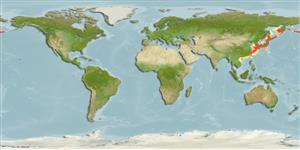Common names from other countries
Environment: milieu / climate zone / depth range / distribution range
Ecology
Marine; demersal; depth range 1 - 900 m (Ref. 56557). Temperate
Northwest Pacific: Pacific coast of northern Japan, northern part of the Sea of Japan, the Tatar Strait, southern Sea of Okhotsk and the Kuril Islands.
Size / Weight / Age
Maturity: Lm ? range ? - ? cm
Max length : 70.0 cm SL male/unsexed; (Ref. 559); max. published weight: 4.0 kg (Ref. 56557)
Inhabits sandy and muddy bottoms (Ref. 9137).
Life cycle and mating behavior
Maturity | Reproduction | Spawning | Eggs | Fecundity | Larvae
Vinnikov, K.A., R.C. Thomson and T.A. Munroe, 2018. Revised classification of the righteye flounders (Teleostei: Pleuronectidae) based on multilocus phylogeny with complete taxon sampling. Molecular phylogenetics and evolution, 125:147-162. (Ref. 122998)
IUCN Red List Status (Ref. 130435)
CITES (Ref. 128078)
Not Evaluated
Threat to humans
Harmless
Human uses
Fisheries: commercial
More information
Age/SizeGrowthLength-weightLength-lengthLength-frequenciesMorphometricsMorphologyLarvaeLarval dynamicsRecruitmentAbundance
ReferencesAquacultureAquaculture profileStrainsGeneticsElectrophoresesHeritabilityDiseasesProcessingMass conversion
Tools
Special reports
Download XML
Internet sources
Estimates based on models
Preferred temperature (Ref.
115969): 0.7 - 17, mean 2.1 (based on 206 cells).
Phylogenetic diversity index (Ref.
82804): PD
50 = 0.7500 [Uniqueness, from 0.5 = low to 2.0 = high].
Bayesian length-weight: a=0.01148 (0.00524 - 0.02518), b=3.09 (2.89 - 3.29), in cm Total Length, based on LWR estimates for this (Sub)family-body shape (Ref.
93245).
Trophic level (Ref.
69278): 3.9 ±0.2 se; based on size and trophs of closest relatives
Resilience (Ref.
120179): Medium, minimum population doubling time 1.4 - 4.4 years (Preliminary K or Fecundity.).
Fishing Vulnerability (Ref.
59153): Moderate to high vulnerability (47 of 100).
